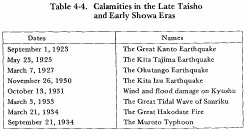- 現在位置
- トップ > 白書・統計・出版物 > 白書 > JAPAN'S MODERN EDUCATIONAL SYSTEM > (4)School Construction
(4)School Construction
Finally it should be explained just how the construction of school buildings proceeded during this period and how positive policies were proposed and adopted.
By the late twenties, the school buildings which had been constructed during the Meiji era were becoming obsolete and moreover there were a series of devastating calamities which caused enormous damage. Table 4-4 indicates the most destructive of these catastrophes.
Table 4-4. Calamities in the Late Taisho and Early Showa Eras

One consequence of these disasters was a rapidly growing concern for the adoption of a program of improved school building construction. Thereafter new schools were built and much attention was paid to repairs and improvements in existing structures. Of all the calamities listed in Table 4-4, the Great Kanto Earthquake and the Muroto Typhoon did the most damage thus requiring a tremendous sum of money and much time to rebuild what had been destroyed. The brick buildings of Tokyo Imperial University were toppled in the Great Kanto Earthquake and those school buildings constructed of wood were destroyed by the ensuing conflagration. As a result, many of the schools constructed thereafter in Tokyo were built with earthquake-proof and fire-proof reinforced concrete. The school building construction practices in Europe were studied and modern buildings began to appear. The impetus for this program came from the long-term aspirations of the then Minister of Home Affairs (and previously the Mayor of Tokyo City) Goto Shinpei (1857 -1929). We can only admire his farsightedness. By planning the construction of three-story, reinforced concrete school buildings with sports decks on the roof, Tokyo was able to accommodate the growing population without expanding the actual dimensions of the school grounds.
The fierce typhoon of 1934, which turned inland at Cape Muroto and swept over Shikoku and the Kinki district (especially the Osaka area), claimed the lives of a large number of teachers and children. The outcomes of this tragedy were to cause great concern among those individuals in the field of education regarding unsafe school buildings and to promote the construction of school buildings which would resist the threats of natural disasters. Thus in December, 1934, instructions were issued which dealt with the construction and maintenance of school buildings. Of particular interest is the section on construction of wooden buildings where detailed regulations regarding the constituent parts of these buildings are specified. This resulted in enormous changes in the construction of school buildings and new techniques and methods began to spread throughout the country.
お問合せ先
(C)COPYRIGHT Ministry of Education, Culture, Sports, Science and Technology
-- 登録:平成21年以前 --